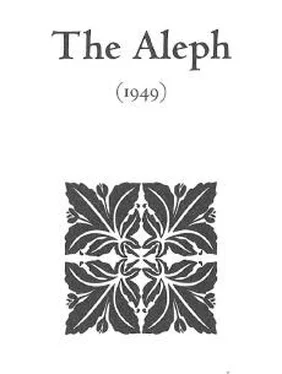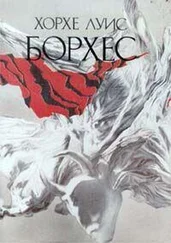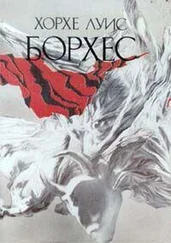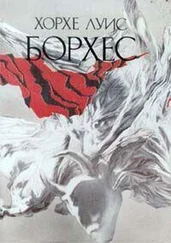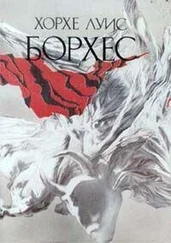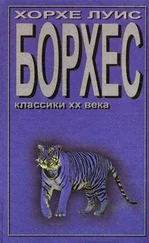Хорхе Борхес - Collected Fictions
Здесь есть возможность читать онлайн «Хорхе Борхес - Collected Fictions» весь текст электронной книги совершенно бесплатно (целиком полную версию без сокращений). В некоторых случаях можно слушать аудио, скачать через торрент в формате fb2 и присутствует краткое содержание. Год выпуска: 1999, ISBN: 1999, Издательство: Penguin (UK), Жанр: Старинная литература, на английском языке. Описание произведения, (предисловие) а так же отзывы посетителей доступны на портале библиотеки ЛибКат.
- Название:Collected Fictions
- Автор:
- Издательство:Penguin (UK)
- Жанр:
- Год:1999
- ISBN:9780140286809
- Рейтинг книги:5 / 5. Голосов: 1
-
Избранное:Добавить в избранное
- Отзывы:
-
Ваша оценка:
- 100
- 1
- 2
- 3
- 4
- 5
Collected Fictions: краткое содержание, описание и аннотация
Предлагаем к чтению аннотацию, описание, краткое содержание или предисловие (зависит от того, что написал сам автор книги «Collected Fictions»). Если вы не нашли необходимую информацию о книге — напишите в комментариях, мы постараемся отыскать её.
Collected Fictions — читать онлайн бесплатно полную книгу (весь текст) целиком
Ниже представлен текст книги, разбитый по страницам. Система сохранения места последней прочитанной страницы, позволяет с удобством читать онлайн бесплатно книгу «Collected Fictions», без необходимости каждый раз заново искать на чём Вы остановились. Поставьте закладку, и сможете в любой момент перейти на страницу, на которой закончили чтение.
Интервал:
Закладка:
* The Auracan or Pampas tongue: The Pampas Indians were a nomadic people who inhabited the plains of the Southern Cone at the time of the Conquest; they were overrun by the Araucans, and the languages and cultures merged; today the two names are essentially synonymous (Fishburn and Hughes). English seems not to have taken the name Pampas for anything but the plains of Argentina.
* Pulpería: A country store or general store, though not the same sort of corner grocery-store-and-bar, the esquina or almacén, that Borges uses as a setting in the stories that take place in the city. The pulpería would have been precisely the sort of frontier general store that one sees in American westerns.
A Biography of Tadeo Isidoro Cruz (1829-1874)
* Montoneros: Montoneros were the men of guerrilla militias (generally gauchos) that fought in the civil wars following the wars of independence. They tended to rally under the banner of a leader rather than specifically under the banner of a cause; Fishburn and Hughes put it in the following way: "[T]heir allegiance to their leader was personal and direct, and they were largely indifferent to his political leanings."
* Lavalle: Juan GaloLavalle (1797-1841) was an Argentine hero who fought on the side of the Unitarians, the centralizing Buenos Aires forces, against the Federalist montoneros of the outlying provinces and territories, whose most famous leader was Juan Manuel de Rosas, the fierce dictator who appears in several of JLB's stories. The mention here of Lavalle and López would indeed locate this story in 1829, a few months before Lavalle was defeated by the combined Rosas and López forces (Fishburn and Hughes). One would assume, then, that the man who fathered Tadeo Isidoro Cruz was fighting with Rosas' forces themselves.
* Suárez' cavalry: Probably Manuel Isidoro Suárez (1759-1843), JLB's mother's maternal grandfather, who fought on the side of the Unitarians in the period leading up to 1829 (Fishburn and Hughes). Borges may have picked up the protagonist's name, as well, in part from his forebear.
* Thirty Christian men... Sgt. Ma}. Eusebia Laprida... two hundred Indians: Eusebio Laprida (1829-1898) led eighty, not thirty, men against a regular army unit of two hundred soldiers, not Indians, in a combat at the Cardoso Marshes on January 25, not 23,1856 (data, Fishburn and Hughes). The defeat of the Indians took place during a raid in 1879. JLB here may be conflating the famous Thirty-three led by Lavalleja against Montevideo (see note to"Avelino Arredondo"in The Book of Sand), Laprida's equally heroic exploit against a larger "official" army unit, and Laprida's exploit against the Indians two decades later.
* Manuel Mesa executed in the Plazade la Victoria: Manuel Mesa (1788-1829) fought on the side of Rosas and the Federalists. In 1829 he organized a force of montoneros and friendly Indians and battled Lavalle, losing that engagement. In his retreat, he was met by Manuel Isidoro Suárez and captured. Suárez sent him to Buenos Aires, where he was executed in the Plaza Victoria.
* The deserter Martín Fierro: As JLB tells the reader in the Afterword to this volume, this story has been a retelling, from the "unexpected" point of view of a secondary character, of the famous gaucho epic poem Martín Fierro, by José Hernández. Since this work is a classic (or the classic) of nineteenth-century Argentine literature, every reader in the Southern Cone would recognize "what was coming": Martin Fierro, the put-upon gaucho hero, stands his ground against the authorities, and his friend abandons his uniform to stand and fight with him. This changing sides is a recurrent motif in Borges; see "Story of the Warrior and the Captive Maiden" in this volume, for instance. It seems to have been more interesting to JLB that one might change sides than that one would exhibit the usual traits of heroism. Borges is also fond of rewriting classics: See "The House of Asterion," also in this volume, and note that the narrator in "The Zahir" retells to himself, more or less as the outline of a story he is writing, the story of the gold of the Nibelungen. One could expand the list to great length.
Emma Zunz
* Bagé: A city in southern Rio Grande do Sul province, in Brazil.
* Gualeguay: "A rural town and department in the province of Entre Ríos"(Fishburn and Hughes).
* Lanús: "A town and middle-class district in Greater Buenos Aires, south-west of the city" (Fishburn and Hughes).
* Almagro: A lower-middle-class neighborhood near the center of Buenos Aires.
* Calle Liniers: As the story says, a street in the Almagro neighborhood.
* Paseo de Julio: Now the Avenida Alem. This street runs parallel with the waterfront; at the time of this story it was lined with tenement houses and houses of ill repute.
* A westbound Lacroze: The Lacroze Tramway Line served the northwestern area of Buenos Aires at the time; today the city has an extensive subway system.
* Warnes: A street in central Buenos Aires near the commercial district of Villa Crespo, where the mill is apparently located.
The Other Death
* Gualeguay chú: "A town on the river of the same name in the province of Entre Ríos, opposite the town of Fray Bentos, with which there is considerable interchange" (Fishburn and Hughes).
* Masoller: Masoller, in northern Uruguay, was the site of a decisive battle on September 1, 1904, between the rebel forces of Aparicio Saravia (see below) and the National Army; Saravia was defeated and mortally wounded (Fishburn and Hughes).
* The banners of Aparicio Saravia: Aparicio Saravia (1856-1904) was a Uruguayan landowner and caudillo who led the successful Blanco (White party) revolt against the dictatorship of Idiarte Borda (the Colorados, or Red party). Even in victory, however, Saravia had to continue to fight against the central government, since Borda's successor, Batlle, refused to allow Saravia's party to form part of the new government. It is the years of this latter revolt that are the time of "The Other Death." See also, for a longer explanation of the political situation of the time, the story"Avelino Arredondo"in The Book of Sand.
* Rio Negro or Paysandú: RíoNegro is the name of a department in western Uruguay on the river of the same name, just opposite the Argentine province of Entre Ríos. Paysandú is a department in Uruguay bordering Rio Negro. Once again JLB is signaling the relative "wildness" of Uruguay is comparison with Argentina, which was not touched by these civil wars at the time.
* Gualeguay: See note to p. 215 above. Note the distinction between "Gualeguay" and"Gualeguay chú"(see note to p. 223 above).
* Ñancay: "A tributary of the Uruguay River that flows through the rich agricultural lands of southern Entre Río sprovince" (Fishburn and Hughes).
* Men whose throats were slashed through to the spine: This is another instance in which JLB documents the (to us today) barbaric custom by the armies of the South American wars of independence (and other, lesser combats as well) of slitting defeated troops' throats. In other places, he notes offhandedly that "no prisoners were taken," which does not mean that all the defeated troops were allowed to return to their bivouacs. In this case, a rare case, Borges actually "editorializes" a bit: "a civil war that struck me as more some outlaw's dream than the collision of two armies."
* Ilkscas, Tupambae, Masoller: All these are the sites of battles in northern and central Uruguay fought in 1904 between Saravia's forces and the National Army of Uruguay.
Читать дальшеИнтервал:
Закладка:
Похожие книги на «Collected Fictions»
Представляем Вашему вниманию похожие книги на «Collected Fictions» списком для выбора. Мы отобрали схожую по названию и смыслу литературу в надежде предоставить читателям больше вариантов отыскать новые, интересные, ещё непрочитанные произведения.
Обсуждение, отзывы о книге «Collected Fictions» и просто собственные мнения читателей. Оставьте ваши комментарии, напишите, что Вы думаете о произведении, его смысле или главных героях. Укажите что конкретно понравилось, а что нет, и почему Вы так считаете.
